Samsung Series 7 NP700Z7C Review
by Jarred Walton on August 16, 2012 2:05 AM ESTInvestigating Samsung Series 7 Thermals and Acoustics
After the fiasco of the Dell XPS 15 launch—frankly, I still can’t believe Dell shipped a laptop that would throttle in every gaming situation I’ve encountered, usually within a couple minutes—we’ve decided to take a detailed look at the temperatures and CPU/GPU clocks on all future laptop reviews. We believe the expectation for some laptop owners is that they should be able to run both the CPU and GPU at a 100% load without dropping clock speeds below the minimum “guaranteed” clocks. That’s pretty demanding, though, and for many users all they really want is for CPU loads to run the CPU at close to maximum turbo clock speeds, while GPU loads (e.g. gaming) will run the GPU at maximum clocks while allowing the CPU to run at lower speeds if necessary—but preferably at least at the base clock of the CPU.
In the case of the 17.3” Series 7, that means the i7-3615QM CPU under load should always run at 2.3GHz or higher and the GT 650M should always run at 745MHz or higher—at least when we’re looking at reasonable conditions where the environment is 80F/27C or below. If the cooling in a laptop can’t reach at least that standard, then the manufacturer should upgrade the cooling or downgrade the components until the cooling proves adequate. With that in mind, let’s take a look at how the Samsung Series 7 handles various loads. We’ll start with the easiest one first: CPU-centric loads (e.g. x264 HD encoding or Cinebench 11.5 SMP in a loop), then we’ll look at what happens with a gaming load (Batman: Arkham City), and we’ll wrap up with a worst-case stress test where we use x264 to encode a 720p video (on cores 2, 3, 4, 5, 6, and 7) while playing Batman: Arkham City (on CPU cores 0 and 1). All of the CPU and GPU clocks and temperatures (and a ton of other elements we aren’t reporting!) are recorded using HWiNFO64.
Last Minute Addendum: Interestingly enough, we conducted the following testing with the original shipping BIOS, but Samsung has an updated BIOS available. We ran the final stress test a second time to see if anything had changed, and it had. Now in our stress test workload, we’re seeing CPU throttling down to a steady 1.2GHz, but the GPU continues to run at 735-835MHz. In other words, Samsung’s BIOS update appears to have gone the opposite direction of Dell’s XPS 15 BIOS releases: Samsung is now throttling the CPU more heavily in order to keep GPU clocks up, where Dell’s latest BIOS is now throttling the GPU to keep CPU clocks up.
Personally, I prefer the CPU throttling, as ThrottleStop is a helpful tool for tuning performance. Also note that CPU throttling when running most games (i.e. no heavy CPU workloads in the background) is generally not a problem with the latest BIOS—only when the system is under a sustained CPU + GPU load have we seen the CPU throttle to 1.2GHz (though of course it’s possible some games will run in such a way that they trigger the CPU throttling). Rather than retesting all areas, we decided to report our initial results as performance outside of the worst-case testing appears to be similar. We’ll update with additional information if we uncover anything more. See below for updated charts.

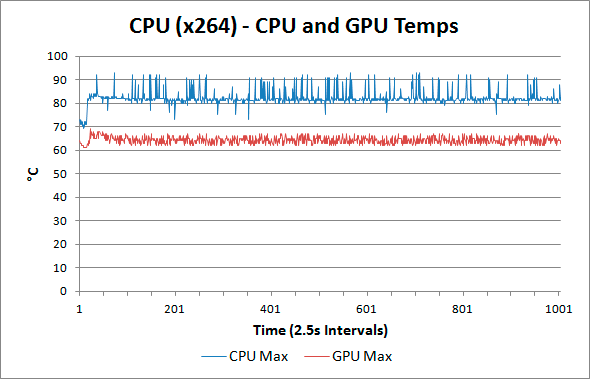
For our tests here, we used x264 HD encoding (for some reason Cinebench kept stealing focus from games and other applications and causing problems on the Samsung notebook, and in general the second x264 encoding pass is quite strenuous). Even with just a CPU load, the Series 7 is already hitting some thermal limits and dropping CPU clocks. What may not be immediately obvious is that the spikes in clock speed up to 3.1GHz match up exactly with the CPU temperature spikes. Basically, the CPU reaches a point where it has enough thermal headroom that Turbo Boost can activate, but then after just a couple seconds (or less) the higher clock speed causes the temperature to jump up 8-12C. While the GPU isn’t really doing anything here, HWiNFO64 apparently keeps it active so that it never clocks down to 93MHz (except for one time early on in the testing). These GPU results are basically our baseline so that we know where the GPU is at when it’s not doing much.
The results here may not be particularly impressive in the grand scheme of things—we’ve seen other notebooks run pretty much constantly at max Turbo Boost without difficulties—but at least everything is working as expected. Users get the “guaranteed” 2.3GHz out of the i7-3615QM, with the potential for the CPU to turbo up to higher clocks under less strenuous workloads. It’s also worth nothing that in a cooler environment (unfortunately, I lack AC so testing was done in an ~80F/27C home—hooray for summer heat!), the notebook should be able to hit turbo frequencies more often. Now let’s see what happens when gaming.
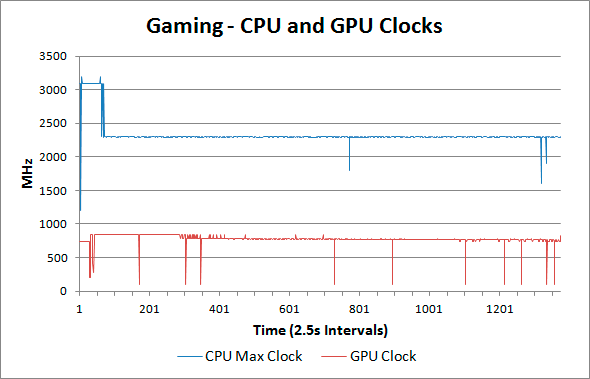
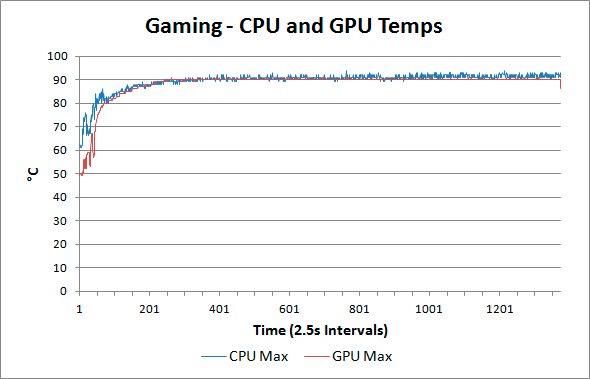
Loading just the CPU wasn’t exceptionally hard on the Series 7, but once we start running games at reasonably complex detail levels (Batman: Arkham City at 1080p Very High in this case) we start to see some additional cracks in the cooling subsystem. CPU clocks are right about where we’d expect: they start at 3.1GHz (and even spike to 3.2GHz a couple times), but after two or three minutes the heat reaches the point where the CPU drops down to the “guaranteed” 2.3GHz (e.g. no Turbo Boost active). There are a few short-lived dips where the CPU clocks dropped to 1.6 to 1.9GHz, but overall the CPU clocks look acceptable. The GPU clocks don’t fare quite as well, unfortunately, and for gaming the dips in GPU clock speed are definitely noticeable.
Most of the time the GT 650M chugs along happily at the rated 745MHz clock speed, and in fact it’s often faster than that—we consistently see GPU clocks of 770MHz and as high as 835MHz. The problem is that we also have 12 dips where the GPU core clock drops way down. The first two (early in the test sequence, most likely during the game’s loading sequence) register 202.5 to 405 MHz, with even the GDDR5 RAM clocking down to 810MHz. Of far more concern are the ten instances during actual game play (we just have Batman sitting idle with a view of the city) when the GPU clock drops all the way to 96-105MHz. That’s less than 14% of the rated clock speed for the GT 650M, and the impact on gaming is immediately apparent—we experienced brief dips into the sub-15 FPS range in practice.
It’s not clear exactly what’s going on, as GPU and CPU temperatures seem to reach a pretty comfortable plateau after 20-30 minutes, but for whatever reason the NVIDIA GPU on occasion will drop down to its minimum clock speed. This may simply be a driver issue, or perhaps Samsung needs to do a bit more fine-tuning of their firmware. Overall, however, the gaming experience is generally good. If you’re a serious multiplayer gamer (e.g. you play at least one game multiple times for an hour or more during the course of a week), or if you’re a competitive gamer (e.g. in a clan or guild of some sort), the gaming experience may be irritating enough that you should look elsewhere. For primarily single player gaming, however, I don’t have a problem with the overall experience. It’s not great, but the GT 650M is fast enough that I could actually live with it as my primary gaming PC in a pinch. (FYI: In practice, 90% of my gaming is still done on a desktop, but much of that is personal preference.)
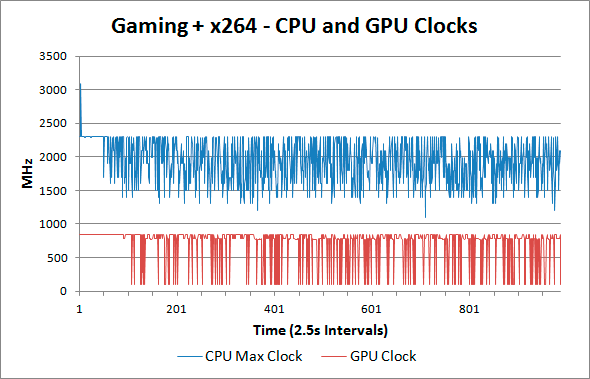
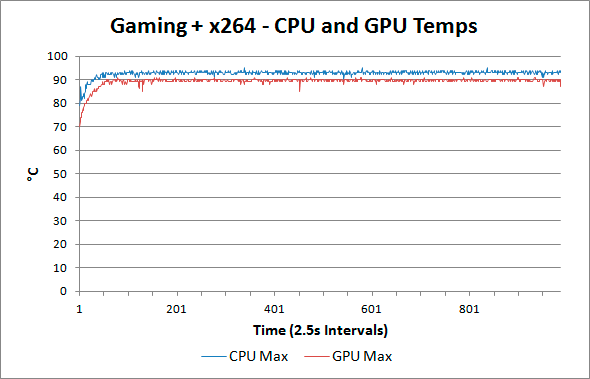
First, keep in mind that our worst-case stress testing is particularly brutal on notebooks. In regular every day use, I have never actually run a workload like this on a notebook. Playing a game is about as demanding as it gets with most notebooks, but we’re presenting these results as a look at how systems cope with 100% loads on all critical components. Also note that long-term, cooling performance tends to degrade as dust builds up, so what starts as a "worst-case" scenario may end up becoming more common in a year or two.
In our worst-case stress testing, just as we experienced with the Dell XPS 15, the wheels start to come off. Dell’s latest A06 BIOS update has come out, we’ve done some initial testing, and it looks like Dell has changed from throttling the CPU to 1.2GHz (unless you use ThrottleStop) to throttling the GPU. Samsung’s Series 7 is a different beast: we get both CPU and GPU throttling when the system is under a truly punishing workload. The CPU clocks drop as low as 1100MHz, with an average clock speed (on the highest clocked core for each sample) of 1947MHz, so clearly the CPU isn’t able to run continually at the rated 2.3GHz. The GPU clocks are all over the place as well, starting out at the maximum Boost Clock of 835MHz for the first few minutes before fluctuating between ~100MHz and 835MHz. The average GPU clock during our 41 minute stress test ends up being 704MHz, but the constant fluctuations are really annoying—Batman would run at 42FPS for a few seconds, then drop to 20FPS, then perhaps settle in at 30FPS for a bit before repeating the sequence.
As for temperatures in our stress testing, both the CPU and GPU seem to hit their maximum sustainable temperatures after just three or four minutes, at which point throttling comes into play to keep the system running. The maximum CPU temperature during our testing was 95C, while the GPU topped out at a slightly cooler 91C. That’s only slightly higher on the CPU than the maximum temperature while gaming, but average temperatures are also higher—we recorded an average CPU temperature of 92.7C (compared to 89.4C while gaming alone) and an average GPU temperature of 89.2C (compared to 88.1C for gaming alone).
The system itself has surface temperatures that are significantly lower than the CPU and GPU core temperatures reported by HWiNFO, and the chassis wasn’t uncomfortably hot. It’s warm certainly, and the rear of the chassis (where the exhaust, CPU, and GPU chips are all located) is quite hot compared to the palm rest and keyboard, but provided you’re not living in a place where the laptop will run in 90F (32C) or higher ambient temperatures you should be okay. I also can’t help but feel the exhaust ports are obstructed by the LCD hinge, which would also increase the likelihood of throttling.
Updated Results for Gaming and CPU+GPU Stress Test with New BIOS
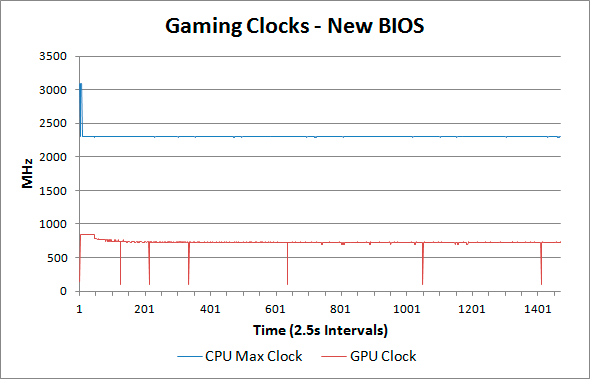

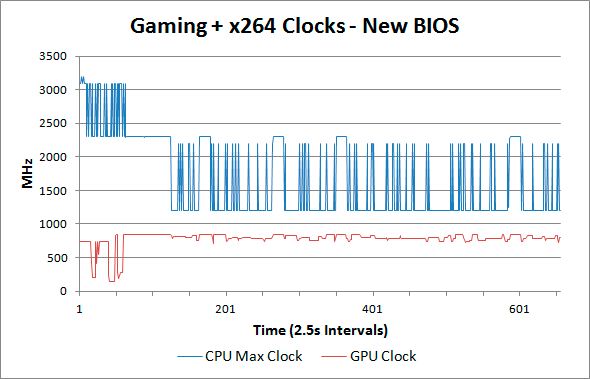
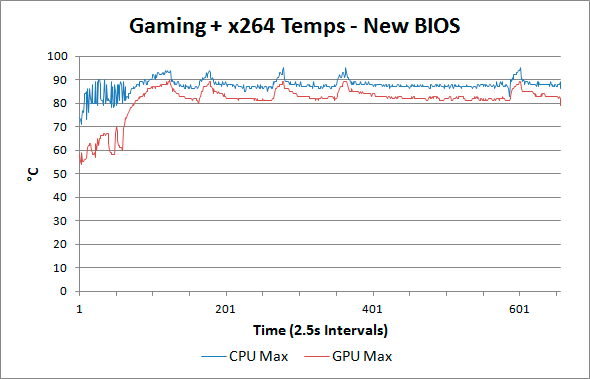
Looking at the gaming and CPU+GPU stress test results with the new BIOS, the only major change is in the stress test where the CPU clocks down to 1.2GHz on a regular basis while the GPU clocks stay closer to the expected range (though they're not always at 745MHz or above). This is generally preferable to throttling the GPU, but most games will suffer a moderate performance penaly from the lowered CPU clocks. ThrottleStop can help in situations like this, where you could shoot for a steady 2.0GHz CPU clock as an example, but given that we didn't see throttling for pure gaming workloads the behavior from the Series 7 is generally acceptable (at least for less demanding users).
Acoustics
Noise levels are decent but not spectacular; I measured a maximum noise level of 43dB under load. I’ve heard substantially louder systems, and honestly I’d rather the Samsung get a bit louder rather than curtailing CPU/GPU clocks. Ideally, we’d want good temperatures and low noise levels, but a quiet system that’s overheating and throttling isn’t desirable. Samsung could easily give up a few dB of noise in order to drop temperatures, and that’s something they should seriously consider if/when they update the BIOS again. At idle, heat and noise aren’t a concern at all, but with a reasonably high-end configuration it’s irrational to expect people to never tax the system.
Ultimately, then, we’re in a similar situation to other thin but potentially powerful laptops: they’re either too thin, too fast, or not built well enough. Perhaps if Samsung had opted for the lower TDP i7-3612QM they would be able to keep thermals in check, or alternately they could use a GT 640M—maybe both. Probably better in the long run would be to use a more potent cooling configuration, even if that means making the notebook slightly thicker and heavier. With the right materials and components, it might be possible to create a thin and fast laptop that doesn't throttle, but doing so without significantly increasing the BoM costs is going to be difficult if not impossible—e.g. look at the $2100 MacBook Pro Retina to see what’s possible (and subtract a couple hundred for the cost of the LCD), and even then the rMBP still appears to throttle under max workloads. If you’re trying to keep pricing in check, however, discretion is simply a better course of action. So basically you can look for laptops that are thin, fast, quiet, and affordable—you can pick any two, possibly even three, but getting all four is basically impossible.










50 Comments
View All Comments
mbishof - Thursday, August 16, 2012 - link
I know it's probably not as sleek or thin, but then neither is the ASUS N56VZ that you suggested for the "technology addict" or "gamer." I want a laptop that acts as mobile workstation by day and gaming laptop by night. What do you think of the lenovo Y580? Right now they have a model with a 1080p screen for under $1k . Pop in a 128GB msata SSD for an additional $150 or so and it seems like that's quite a compelling choice. I'd love to see an in depth review of that machine.JarredWalton - Thursday, August 16, 2012 - link
Honestly, it's extremely similar to the ASUS N56VZ but with a couple minor differences. First is that the ASUS appears to get slightly better battery life, which is related to the second aspect: the Y580 comes with a GTX 660M GPU. It's only a slight clock speed increase from the GT 650M, and I'm not sure I'd call the 660M worthy of the GTX branding, but it's still faster.The keyboard on the Y580 looks nearly identical to the ASUS layout, they both come with Blu-ray, and most of the specs are about the same elsewhere. It's really just a preference for the LCD (ASUS has a matte 1080p display whereas the Lenovo is glossy), plus the ASUS is cheaper, and lastly ASUS isn't afraid to send us review units so I've actually had hands-on time with the N56VZ. I should also mention that Lenovo uses a 5400RPM HDD with a 32GB SSD cache, where ASUS uses a 7200RPM HDD with no cache. If you're going to replace the HDD with an SSD, there's not much point in having the 32GB mSATA SSD hanging around IMO (or as you note, you could look for an mSATA SSD).
mbishof - Thursday, August 16, 2012 - link
Unfortunately my retailers of choice do not offer a N56VZ in the US with a 7200RPM hard drive. Also, the N56VZ uses a GT650 with DDR3 memory which a trustworthy site has informed me will not perform as well as the DDR5 version (although they did point out the boost in clock frequency will compensate the slower memory somewhat). Lenovo does offer a variant of the Y580 with a 500GB 7200RPM drive and no mSATA SSD so my plan is to just do a fresh install on a 128GB mSATA that I pick up from crucial. Sounds like a driver installation nightmare waiting to happen but who knows, it could work.sigmatau - Thursday, August 16, 2012 - link
I'm not sure I'd buy a Lenovo after I found a survey they did about matte vs glossy displays.... 6 years ago. I guess it didn't matter that 86% of the participants voted for matte and spitted on glossy. They removed the survey from their forums... probably from shame.I mean who cares what the customer wants.
http://arstechnica.com/gadgets/2006/10/8022/
JarredWalton - Friday, August 17, 2012 - link
One problem with that Ars article is this line: "There are some advantages to having a glossy screen: in particular, outdoor visibility is greatly increased." WTF? Outdoor visibility is increased by glossy? Where are they using such screens "outdoors"? Because all I get on glossy screens outside is a nice reflection of my face. :-\Dribble - Thursday, August 16, 2012 - link
It should never throttle on a brand new laptop - if it gets that hot then the cooling is insufficient. This means inconsistent performance, noisy cooling as the fan is maxed out, and the cpu/gpu dying young due to being run so hot all the time.Remember that laptop is new, the fan is clean, it's as good as it will get. Use it for a few months and the cooling system will have dust in it and be significantly less efficient - the laptop will be continuously throttling. Sure you can clean it out, but most people don't want to have to clean out the fans every month to keep their machine usable.
JarredWalton - Thursday, August 16, 2012 - link
I'm not sure how you consider about three pages worth of discussion on throttling and a conclusion that says "gamers and enthusiasts should probably look elsewhere because of the throttling issues" as being accepting. There are many people who would only occasionally game, and if you want a nice looking notebook with a good display and keyboard there aren't that many options. Certainly the Series 7 looks nicer than the ASUS and Lenovo laptops mentioned elsewhere, with a better keyboard layout as well. For everyday use, I'd take the Samsung over the other two, but I'd do it knowing that gaming/graphics are going to have thermal issues at times. That means you're spending about $250 on hardware you won't use much, but people have done worse things.bennyg - Saturday, August 18, 2012 - link
I would think the issue is more longevity rather than performance.Remember, most people don't even think to blow out fans/grilles with air, let alone pull the thing apart and clean it properly. Add dust to something that can't cool itself properly to start with = problems.
Or am I just old-fashioned in wondering what the product's use will be like in 1 or 2 years' time. All I'm supposed to consider is looks and price and maybe a few spec tags like "i7" and "8gb ram". Ugh I hate 'consumers'.
MadMan007 - Thursday, August 16, 2012 - link
The temperature graphs have MHz for the vertical axis instead of degrees.JarredWalton - Thursday, August 16, 2012 - link
Ugh... I hate it when I do things like that. These are all manually created charts as well (for the clocks/temps), so I have to go into Excel, edit the chart, then take a screen capture, paste into Photoshop, crop, save, and upload the result to our CMS engine. What a pain! Anyway, the charts are all fixed now (I hope!)